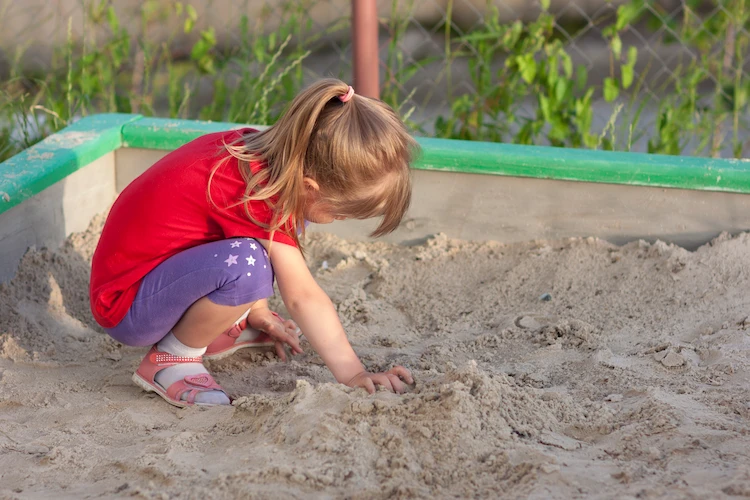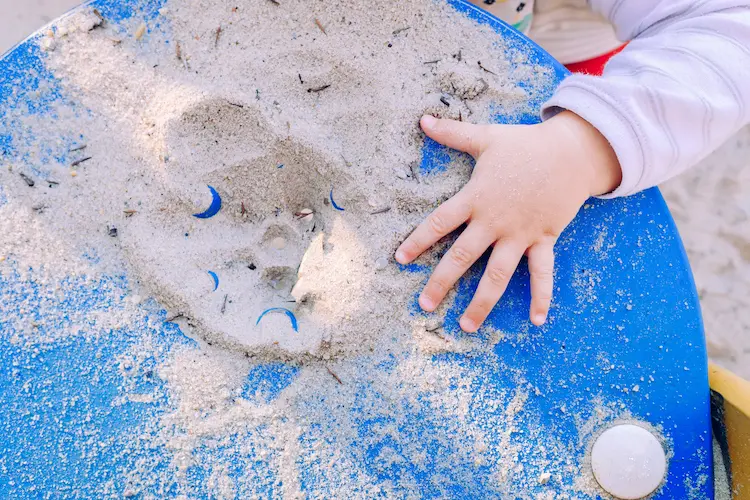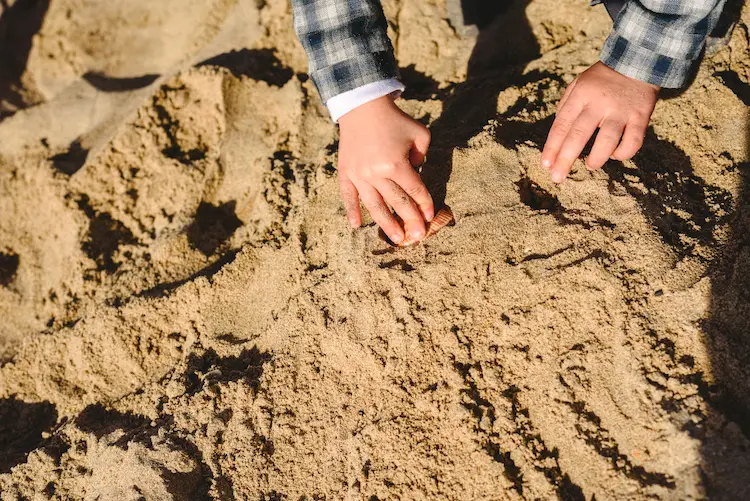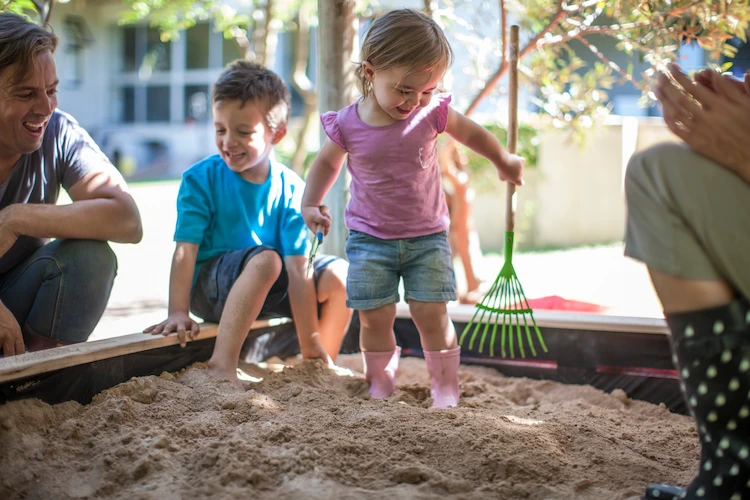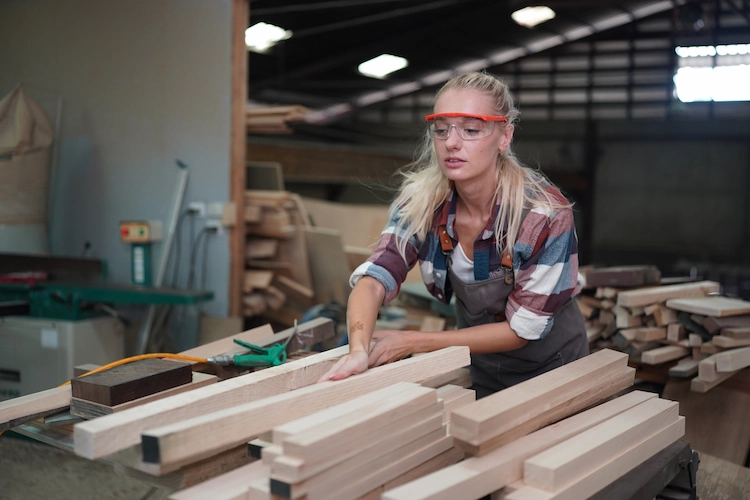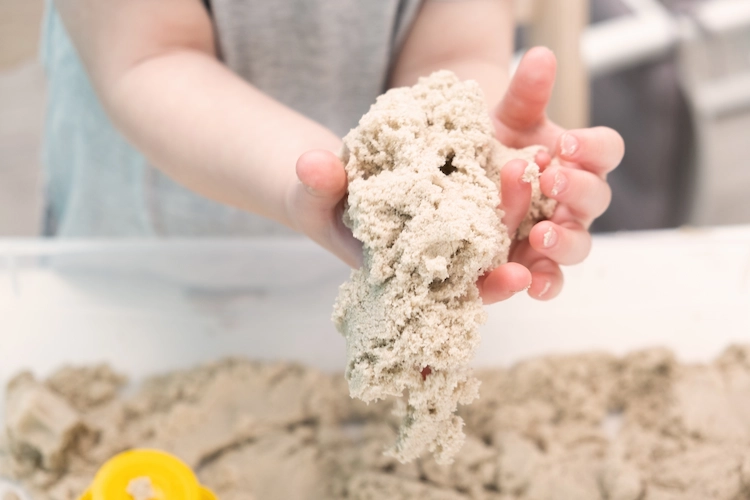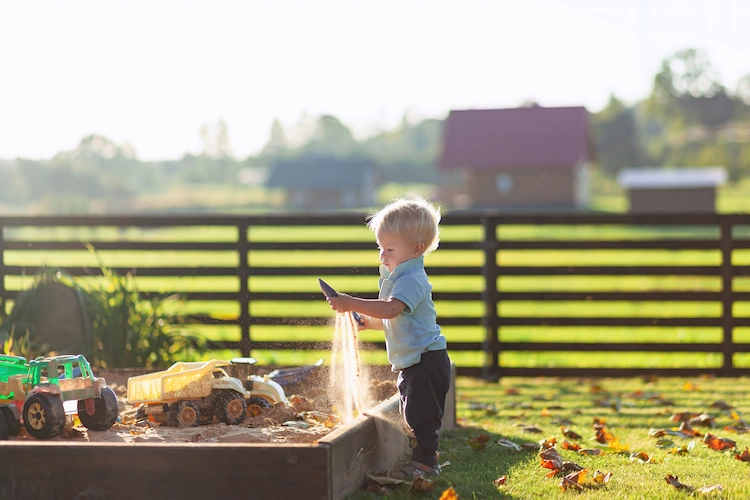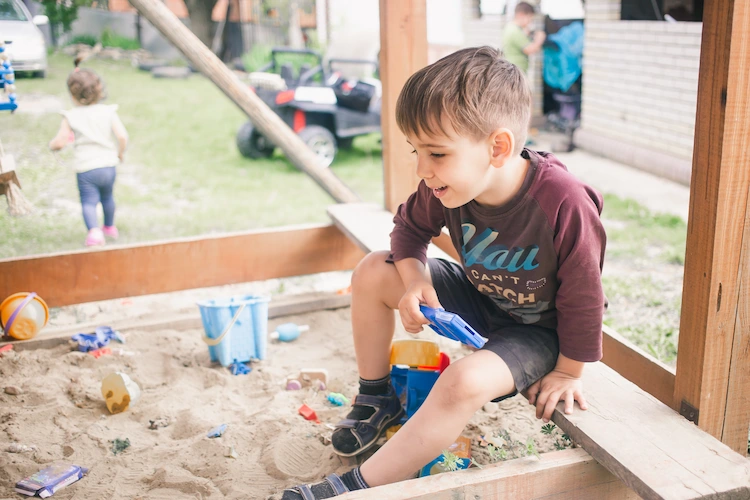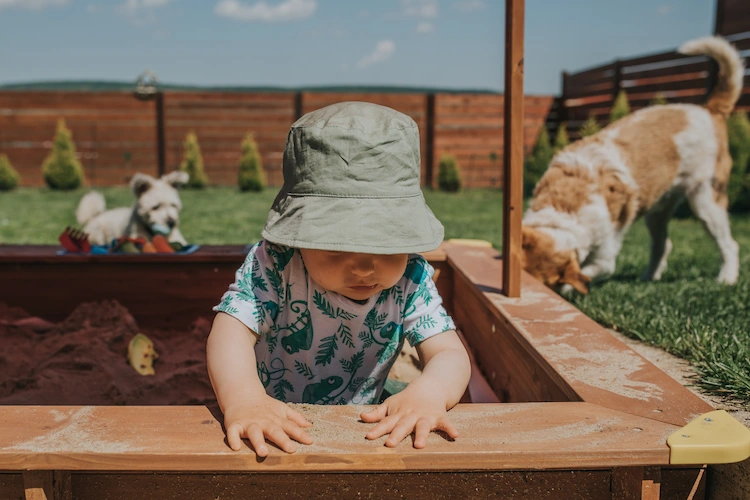Do you want to build a simple sandbox for kids and provide a play area for your little ones to enjoy with such a DIY project for the whole family? Below you will find a guide and some practical advice on how to adapt the play area to the garden space.
Every parent knows how important playing is to child development, but is it possible to build a sandbox for kids by yourself? Although this requires some craftsmanship, it would be possible to create one of the most popular toddler playgrounds with simple steps. Thus, your little ones can not only spend entertaining time outside, but also give free rein to their imagination. Would you consider such a DIY project for the space available in your garden area? Below you will find instructions and useful advice that will help you give your children even more summer fun.
What to Consider Before You Build a Sandbox for Kids?
Children love to play with sand and love building castles, making molds with it and just digging in it. Pre-made sandboxes sold at children’s stores are also nice, but they are on the small side and made from plastic. Therefore, if you have more than two children or have children visiting often, it would make more to provide them with a little more space to play in the garden. The construction might seem difficult at first glance, but a sandbox with a lid or simple digging boxes are made of wooden boards. You may also have to do a little digging for this, but you can also leave the garden soil as a natural base for the sand.
By adding a lid to the sandbox you protect the playground from bad weather and other influences. As natural material, wood is also well suited for such constructions and can be easily assembled in various garden areas. However, before you integrate a sandbox in the garden, you should think carefully about what location on your property is best suited for it. Preferably, do not place the playground directly against house walls, or behind shrubs and privacy screens, so you can monitor your little ones playing.
What Does a Sandbox Look Like and What Are the Most Common Designs?
A sandbox is usually a shallow pit of sand in a wooden box for children to dig in and play with sandbox toys. Since sandboxes are designed for outdoor areas such as parks or playgrounds, such structures can be easily installed in garden areas if there is enough space. In addition, you can build a sandbox for kids, either by erecting it as a structure above the garden floor or as an in-ground pit. The most important thing is to clearly define the perimeter that will separate the sandbox from the rest of your garden so that this area doesn’t get messy. You can find numerous options beyond the professional models, built for patios or gardens in different styles. Here are the most common of them:
- For example, an above-ground sandbox with a frame is a type of sandpit that can be built in any shape. It is most practical to opt for a square or rectangular sandbox with a framed wooden edge.
- If it is a so-called digging box, you dig it directly into the ground and surround it with wooden boards or larger stones. Most people use impregnated wood or river stones. Depending on the layout of your garden, you can choose any shape.
- With prefabricated sandboxes, people use a kit, which is usually made of plastic. However, such models are smaller, but are equipped with fun elements and motifs for children.
- You can also build a higher table as a sandbox for kids. This is similar to the sandbox, but is kept compact and is raised above the ground. This way the little ones can stand next to the sand table and play with it without having to climb into it.
Consider Size and Safety When Building a Sandbox
Before building, try to level the garden ground and clear at least 10×10 feet/3 x 3 m area. This should also still be permeable, in which case you must not flood the sandbox and mow underlying lawn first. For example, do you have a shady tree under which you can build a sandpit for kids? Then you should also consider that without a lid tree branches, leaves or tree fruits will fall in it and require more frequent cleaning as well as protection. In addition, this also poses a certain risk of injury, which is why a covered sandbox would be the better option. You can also opt for a thematic form by choosing seashells or other motifs for your sandbox. For example, a popular option is to construct the sandbox as a boat.
Although the size of such a playground can vary, you should allow at least 6,5×6,5 feet/2×2 meters of indoor space for several children. The square shape is usually suitable for small children from 2 to 5 years. In addition, by building a sandbox in your own backyard, you can also involve your little ones in the DIY project and have family fun. If they participate, toddlers can learn a lot. Many types of wood can be used for the structure, and you can make the project cheap by using recycled building materials in an environmentally friendly way. Here are some more factors to consider when choosing sand.
Choose Suitable Materials to Build a Sandbox for Kids
You can opt for sustainable options, for example by using PET bottles, old plastic baseboards or other recycled materials. As far as using old tires is concerned, this would also be a cheap and versatile option. However, due to the irregular shape of sandstone, it will not be possible to place normal benches with backs that will turn into a cover. Oak or larch planks last longer but are more expensive, while hardwood is more difficult to work with. Make sure that all parts are treated with antiseptic to extend the life of the wooden structure.
In addition, if you build a sandbox for kids, you will need a piece of moisture-resistant, but porous material. For this purpose, scenic fabric or geotextiles are suitable. The material will separate the soil from the sand, preventing them from mixing, and the porous structure will allow moisture to drain into the soil. The material also acts as a weed blocker and does not allow earthworms to crawl out of the soil. It is also important to pay attention to the quality of the filler. The ideal option is the sand sold in the store. It’s gone through several stages of cleaning and processing, up to grinding the sharp corners of the sand grains. This filler is ideal for sandboxes made of plastic, because it does not scratch the sides of the box. High-quality sand is characterized by excellent flowability, has a uniform shade and does not stick to dry palms.
What Kind of Sand to Choose to Build a Sandbox for Kids?
- Use a suitable type of sand that is not particularly sticky when building a children’s sandbox. Luckily, there is also play sand made specifically for this purpose. It is usually pre-washed and sieved so that children can play with it without any safety concerns. To build a sandbox for kids about 3 inches/10 cm deep, you will need about 810 lbs of it. To keep the project cheap, you should buy the play sand in bulk as it is usually more expensive in individual bags.
- You can also save on costs by choosing crushed sand. This is similar to play sand, but can be dirtier and coarser. However, you can rinse it off with a garden hose and let it dry in the sun.
- There is kinetic sand available these days that can be bonded and makes cleaning easier. This is suitable for playing on a sand table and is a popular option among children.
- Another option is to use rubber mulch instead of sand. It is a soft and springy material that is usually less expensive than sand in bags.
What Is the Best Location for a Sandbox in the Garden?
It is very important to consider the cleanliness of the play area before deciding where to place your sandbox. Therefore, it would be wise to consider where the sand will go after your children play with it. Place it far enough from your home so that sand doesn’t get inside. Even a sandbox with a lid does not guarantee that the area will always be clean and tidy. That is why such a playground, laid out in the yard or garden, should be placed in a highly visible, but not windy place. Otherwise, the sand will constantly fly around and pose a danger to children and adults.
You can also equip a sandbox with hinged lid or seats, and position it so that part of it remains in the sun. The other half should be in the shade, for which you can use a shed or other options such as trellises or hedges. If you place a sandbox with a cover in a sunny location, you may be able to surround it with shady elements. Such a covered sandbox would keep the sand inside and protect it during rain or storms. Without further ado, here are some easy-to-follow steps to realize such a DIY project.
How to Build a Sandbox for Kids?
This is an example version that you can use as a guide if you want to consider such a project.
- Begin the project by measuring the selected garden area. You can use a tape measure to measure the dimensions of the future sandbox.
- Then mark the boundaries either with a rope tied to poles fixed in the ground or with chalk.
- Now you can start cutting the wood slats for the frame of your sandbox. For this example you will need 12 pieces of 4×4 inches/10cm x 10cm wooden planks, which you will cut to the length you measured for your sandbox minus 4 inches/10cm, as the sandbox frame pieces need to fit together on the sides. Of course, you can also have them made by a carpenter. Just make sure all sides are well sanded and have no sharp edges.
- After you cut the wooden planks, you can use the first four pieces to define the perimeter of your sandbox.
- If you build a permanent sandbox, you can dig up the garden soil in which it will fit. For the depth, use the amount of sand and the size of the desired sandbox as a guide. The layer does not have to be too deep and you can add, for example, a layer of sand about 1 inch/3 cm thick to level the floor surface if it is uneven.
- Lay the first frame by positioning the wood planks, making sure each side is straight.
- Then cut each corner square and use framing angles at the corners of your future sandbox. In this way you will make sure that each piece fits together with the other.
- Then continue by adding the second frame. With the first side aligned well, the second layer should fit over the first. You will need to overlap the corners by changing the direction at the side fit.
- Now you can attach the two sides by screwing the first and second frames together with deck screws at 20-22 inches/60cm intervals around the frame.
- The next step is to line the sandbox with the woven fabric. You can also use fleece or plastic sheeting to coat the base. Try to cover all corners and edges and make sure all sides of the box are well protected.
- First you can put on the top frame by positioning the last four pieces of wood over the existing frame structure. As you do so, you should again overlap the corners and screw the third frame into the second to secure the fabric or plastic cover on either side. You can simply cut off the excess material from the outside edge of the frame.
- The last step when you build a sandbox for kids is to fill the interior. Use your chosen filling material and get the sandbox ready for your little ones to use.
- For added appeal and even more fun, you can paint the sandbox with your children and make it more colorful, depending on their preferences.
Tips tor Cleaning and Maintaining the Sandbox
- Make sure the sand used for playing is well washed and sieved. High-quality sandstone is dust-free and is obtained from the deepest layers of sand. However, even high quality play sand requires regular cleaning and care, as dirt can quickly accumulate
- Also make sure that no leaves, sharp objects or other potential hazards end up in the sandbox.
- If you have pets such as dogs or cats, or wild animals visit your garden, you should also prevent them from using the sandpit as a toilet. This can not only cause bad odors, but also pose health risks. Animals secrete parasites that can accumulate in the sand and enter the human body. Such are, for example, roundworms in dogs and cats.
- Try not only to rake out leaves and debris every week, but to completely change the sand once every year or two to prevent any health risks.
Now, hopefully, you learned more about this great idea and will try to build a sandbox with your own hands. There are no hard and fast guidelines as to the design and shape, although you should also cover the playground. In this way you protect your little ones from branches and bugs that might fall from trees. After construction, check the structure for any defects to ensure the safety of your children. If you find any sharp edges, you can sand them down and then impregnate the areas again with a disinfectant. For an improved aesthetic appearance and to protect the wood from moisture, you can paint the structure with oil or acrylic paint. If you use light shades the sandbox will be more appealing to children.

